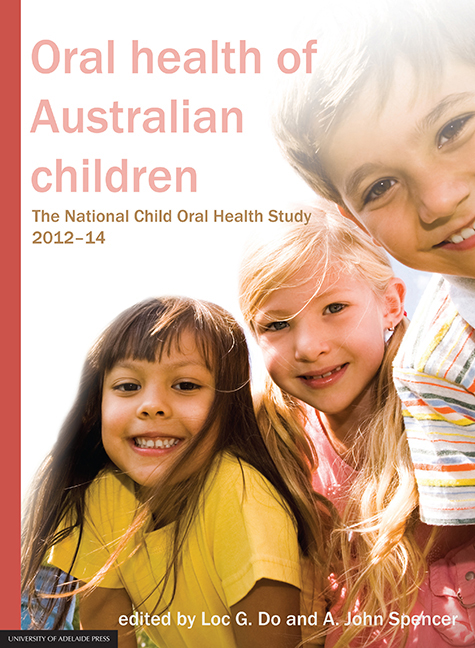Book contents
- Frontmatter
- List of Contributors
- Contents
- Preface
- Executive Summary
- 1 Children's oral health – assessing and improving oral health
- 2 Measuring child oral health and its influences
- 3 Data weighting, consideration and estimation procedures
- 4 Measuring representativeness of the study participants
- 5 Children's oral health status in Australia, 2012–14
- 6 Patterns of dental services use by Australian children
- 7 Australian children's oral health behaviours
- 8 Australian children's general health behaviours
- 9 Social gradients in child oral health
- 10 Oral health status and behaviours of Indigenous Australian children
- 11 Trends in child oral health in Australia
- 12 Interpretation of findings and a way forward to improving oral health and dental care
- 13 Appendix
- State and territory survey personnel
- Symbols
- Abbreviations
- Place names
- Glossary
- List of tables
- List of figures
7 - Australian children's oral health behaviours
Published online by Cambridge University Press: 05 September 2017
- Frontmatter
- List of Contributors
- Contents
- Preface
- Executive Summary
- 1 Children's oral health – assessing and improving oral health
- 2 Measuring child oral health and its influences
- 3 Data weighting, consideration and estimation procedures
- 4 Measuring representativeness of the study participants
- 5 Children's oral health status in Australia, 2012–14
- 6 Patterns of dental services use by Australian children
- 7 Australian children's oral health behaviours
- 8 Australian children's general health behaviours
- 9 Social gradients in child oral health
- 10 Oral health status and behaviours of Indigenous Australian children
- 11 Trends in child oral health in Australia
- 12 Interpretation of findings and a way forward to improving oral health and dental care
- 13 Appendix
- State and territory survey personnel
- Symbols
- Abbreviations
- Place names
- Glossary
- List of tables
- List of figures
Summary
Patterns of toothbrushing practices
Brushing teeth with toothpaste is a widely adopted oral health behaviour in Australia (Slade et al. 2006). There is evidence that more than 90% of Australian children brush their teeth at least once a day (McLellan et al. 1999; Armfield & Spencer 2012) and that almost all children do so with a toothpaste containing fluoride (Armfield & Spencer 2012; Slade et al. 1995). Toothbrushes and fluoride toothpaste are readily available throughout the country and dental and other health authorities recommend brushing.
A great deal of evidence over a number of decades has found that regularly brushing children's teeth with fluoridated toothpaste reduces the risk of dental decay (Marinho et al. 2003a; Walsh et al. 2010). Toothbrushing not only removes plaque, which consists mostly of bacteria and is a risk factor for oral disease, but can be used to apply fluoride to the teeth via the application of toothpaste.
Australia's fluoride guidelines advise that brushing with fluoridated toothpaste commence from the age of 18 months (Australian Research Centre for Population Oral Health 2012). Table 7-1 shows the percentages of children who indicated that they had commenced brushing their teeth before the age of 18 months, by both the child's current age and various demographic and socioeconomic characteristics. The data are based on the recollection of the reporting parent, so parents of older children were having to recall the age of first brushing from further in their past than were parents of younger children. Overall, just over one-third of children commenced brushing with toothpaste before 18 months of age. There was little variation in reported early brushing commencement by child age at the time of the study.
Children were more likely to brush with toothpaste prior to 18 months if their parents were Australian born (36.0%) compared to those with an overseas-born parent (30.3%). In addition, the percentage of children brushing early was higher for those children whose parents had vocational (37.1%) or tertiary education (35.5%) than for those whose parents had no schooling beyond high school (29.2%). There was an income gradient in early-child toothbrushing. The lowest percentage was shown for children from the lowest household incomes (28.7%), followed by children from a medium household income (35.6%), with the highest percentage for children from families with a high household income (38.3%).
- Type
- Chapter
- Information
- Oral Health of Australian ChildrenThe National Child Oral Health Study 2012-14, pp. 178 - 211Publisher: The University of Adelaide PressPrint publication year: 2016



